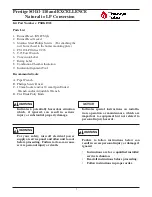
12
center cover. Release the handle from the raised position
by pulling the stopper pin. Lower the handle to make sure
that the blade guard moves properly. Make sure shaft lock
has released spindle before making cut.
(Fig. 14)
Dust bag (Fig. 17)
The use of the dust bag makes cutting operations clean
and dust collection easy. To attach the dust bag, insert
the dust nozzle into the dust spout on the blade case and
fit the bag’s entry port over the dust nozzle.
When the dust bag is about half full, remove the dust bag
from the tool and pull the fastener out. Empty the dust bag
of its contents, tapping it lightly so as to remove particles
adhering to the insides which might hamper further
collection.
NOTE:
If you connect a vacuum cleaner to your saw, more
efficient and cleaner operations can be performed.
Securing workpiece
WARNING:
• It is extremely important to always secure the
workpiece properly and tightly with the vise. Failure to
do so can cause the tool to be damaged and/or the
workpiece to be destroyed. PERSONAL INJURY MAY
ALSO RESULT. Also, after a cutting operation, DO
NOT raise the blade until the blade has come to a
complete stop.
Sub-fence (Fig. 18)
This tool is equipped with the sub-fence which should
ordinarily be positioned as shown in the figure.
However, when performing left bevel cuts, set it to the left
position as shown in the figure.
CAUTION:
• When performing left bevel cuts, flip the fence over to
the left position as shown in the figure. Otherwise, it will
contact the blade or a part of the tool, causing possible
serious injury to the operator.
(Fig. 19)
Sub-fence R (optional accessory) (Fig. 20)
The sub-fence R should ordinarily be installed on the right
side of the guide fence. Insert the rods of the sub-fence R
into the holes in the guide fence. Tighten the screws to
secure the sub-fence R.
CAUTION:
• When performing right bevel cuts, never use the sub-
fence R. It will contact the blade or some part of the
tool, causing a serious injury to operator.
Vertical vise (Fig. 21 & 22)
NOTE:
• When using the holder assembly, install it on the holder
as shown in the figure.
Position the vise arm according to the thickness and
shape of the workpiece and secure the vise arm by
tightening the screw. If the screw to secure the vise arm
contacts the guide fence, install the screw on the opposite
side of vise arm. Make sure that no part of the tool
contacts the vise when lowering the handle fully and
pulling or pushing the carriage all the way. If some part
contacts the vise, re-position the vise.
Press the workpiece flat against the guide fence and the
turn base. Position the workpiece at the desired cutting
position and secure it firmly by tightening the clamp screw
of the vice.
The maximum thickness of the workpiece which can be
secured by the vertical vise is 120 mm.
Horizontal vise (optional accessory)
(Fig. 23)
The horizontal vise can be installed in two positions on
either the left or right side of the base. When performing
15° or greater miter cuts, install the horizontal vise on the
side opposite the direction in which the turn base is to be
turned. By flipping the vise nut to the left, the vise is
released, and rapidly moves in and out. To grip the
workpiece, push the vise knob forward until the vise plate
contacts the workpiece and flip the vise nut to the right.
Then turn the vise knob clockwise to secure the
workpiece.
The maximum width of workpiece which can be secured
by the horizontal vise is 200 mm.
When installing the horizontal vise on the right side of the
base, also use the sub-fence R to secure the workpiece
more firmly. Refer to the “Sub-fence R” section described
on previously for installing the sub-fence R.
CAUTION:
• Always set the vice nut to the right fully when securing
the workpiece. Failure to do so may result in insufficient
securing of the workpiece. This could cause the
workpiece to be thrown, cause damage to the blade
sub-fence or cause the dangerous loss of control of the
tool.
Holders and holder assembly (optional
accessories)
The holders and the holder assembly can be installed on
either side as a convenient means of supporting
workpieces horizontally. Install them as shown in the
figure. Then tighten the screws firmly to secure the
holders and the holder assembly.
(Fig. 24)
When cutting long workpieces, use the holder-rod
assembly (optional accessory). It consists of two holder
assemblies and two rods 12.
(Fig. 25)
CAUTION:
• Always support long workpieces level with the top
surface of the turn base for accurate cuts and to
prevent dangerous loss of control of the tool.
OPERATION
CAUTION:
• Before use, be sure to release the handle from the
lowered position by pulling the stopper pin.
• Make sure the blade is not contacting the workpiece,
etc. before the switch is turned on.
• Do not apply excessive pressure on the handle when
cutting. Too much force may result in overload of the
motor and/or decreased cutting efficiency.
• Gently press down the handle to perform the cut. If the
handle is pressed down with force or if lateral force is













































